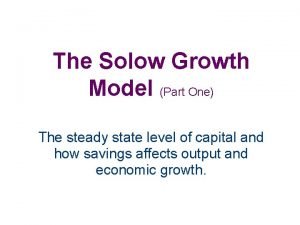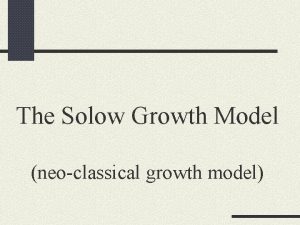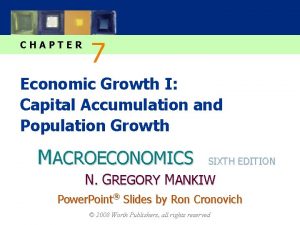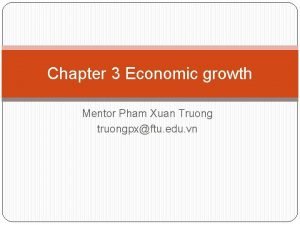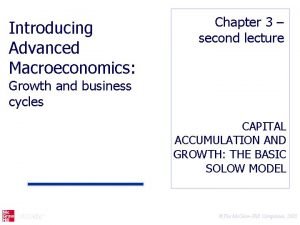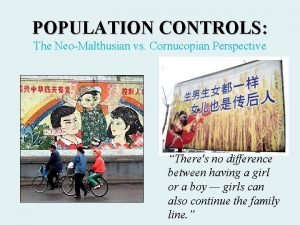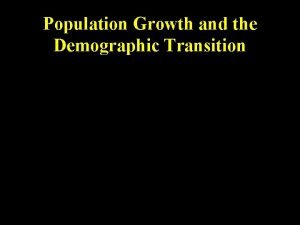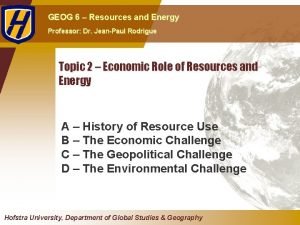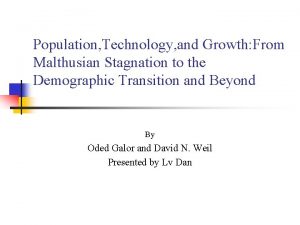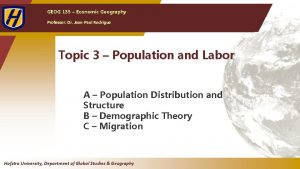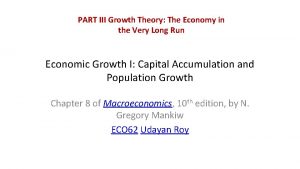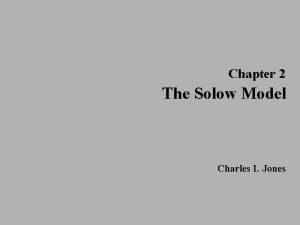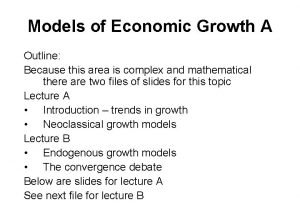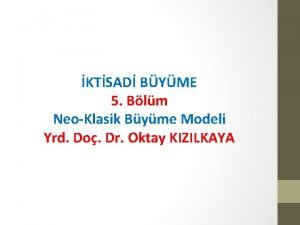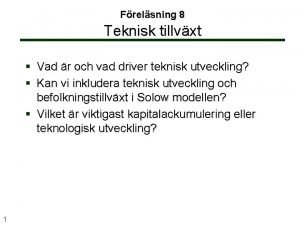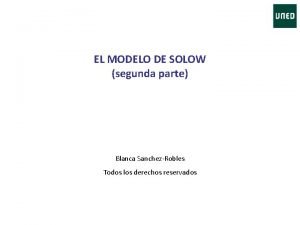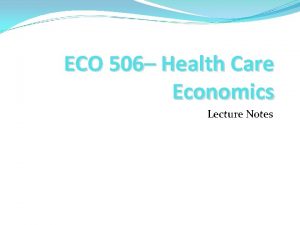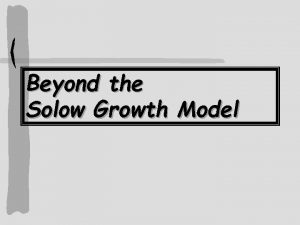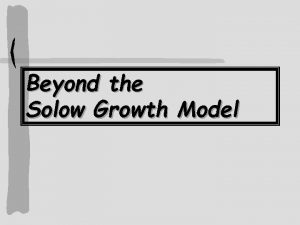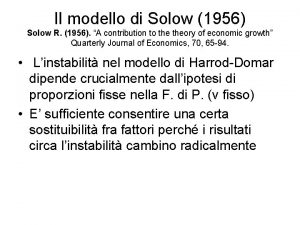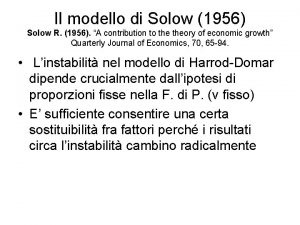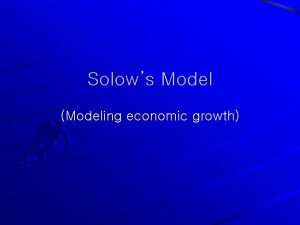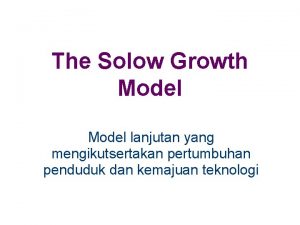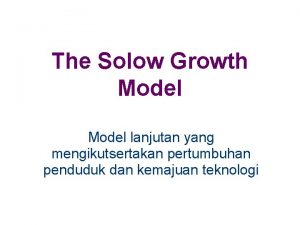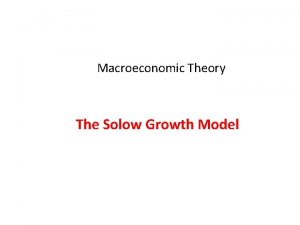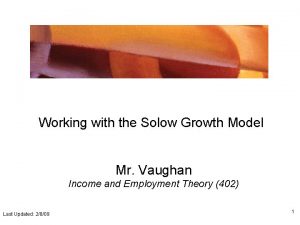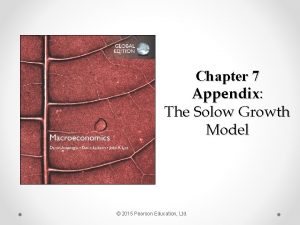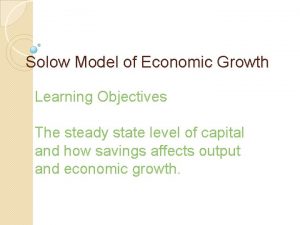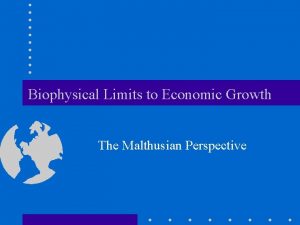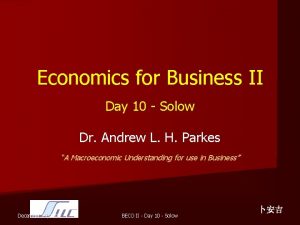Lecture 14 Malthusian Model Economics Growth Solow model







































- Slides: 39

Lecture 14 Malthusian Model

Economics Growth Solow model explains all growth facts for industrialized countries p Why are many poor countries not growing? p Why did all countries stagnate before 1800? p

The Malthus Model 1798: "Essay on Population" p Explains stagnation as resulting from limited supply of land population growth p

Outline Production function uses land labor p People decide on number of children p Population growth offsets productivity growth p

Differences to Solow Model Solow model does not consider land as an input p Solow model takes population growth as constant p

Structure of the Model Consumers work on their own farm (no firms in the model) and decide to consumption and fertility p Each consumer owns an equal share of land p Law of motion for population is determined by fertility decisions p

The Consumer cares about consumption and number of children p Consumer works one unit of time, owns equal share of land, and keeps farm output p Each child eats units of consumption p

The Maximization Problem p Consumer takes income chooses and as given and

The Solution p Plugging in the constraint: p First-order condition:

Result Number of children depends positively on farm income p The richer the consumer is, the more children she will have p

Land Population Total amount of land X is fixed; for simplicity, assume X=1 p Population size is denoted by p Amount of land person: p

The Farm p Farm technology is Cobb-Douglas in labor and land (z is productivity): p One unit of labor is supplied ( land person is ) and

The Law of Motion for Population p Population tomorrow is population today times children person: p Plugging in actual

Convergence in Population

Computing the Steady State p Find steady-state population p Find steady-state income p Income is independent of z! : :

The Malthusian Mechanism p Fertility in the steady state: Income adjusts such that each person has one child (zero population growth) p Therefore income adjusts to the same level regardless of productivity p

Explanation for the Result When income in high, people have many children and population growth is high p High population growth lowers income until each parent has just one child p

What Happens if Productivity Increases? Increase in z will lead to higher income and higher population growth p Higher population growth pushes incomes down p Ultimately, a new steady state is reached with higher population, but same income person p

A jump in productivity

Long-Run Predictions Income per capita will be roughly constant over time p Increase in productivity will increase world population without raising living standards p Inventive countries and regions will have higher population growth p

Why is the Solow Model Different? The Solow model does not have endogenous fertility-population growth assumed to be constant p The Solow technology does not use landpopulation increases do not lower income per capital p

Why Do We Use Both Models? p p The Malthus model is an accurate description of the world until 1800 --Agriculture and land were important --Income and fertility were positively related The Solow model is an accurate description of industrialized countries --Agriculture is small sector today --Fertility no longer closely related to income

How Did We Get From Malthus to Solow? p Two promising approaches: --Technological change replaced land -based technology by capital-based technology --People started to invest in human capital instead of having many children

Technological Changes and Growth Industrialization replaced land-based technology by capital-based technology p Since the importance of land diminishes, returns to population size no longer decreasing p Growth in income per capita is possible even as population is growing p

The Malthus Model with a Constant -Returns Technology p Consumer: p Firm:

Results p Fertility Choice: p Output person: p population growth as a function of z:

Implication Productivity growth (increase in z) is not offset by population growth p Income per capita increases with z, as in the Solow model p However, population growth ever increasing p Can get transition in theory, not in practice p

The Demographic Transition The income-fertility relationship also changed p In late 19 th century, mortality rates and fertility rates fell steeply in England, U. S. , and Germany p Today richer people have fewer children p All industrialized countries experienced demographic transition p

The Malthus Model with Fixed Fertility p Exogenous limit on fertility: p Decreasing-returns technology:

Results p Constant population: Constant labor ( ) and land person( ) p Resulting output person: p

Implication Once again, income per capita increases with z, as in the Solow model p However, share of land stays constant p In data, share of land in output declining over time p True explanation is probably a combination p

Why Did Fertility Fall? Increased cost of children (education, no more child labor) p Low mortality p Social security p Increased female labor-force participation p

The Current Situation in Developing Countries Many developing countries are still in between Malthus and Solow p Agriculture plays a more important role p Less education, less social security, less female labor force participation, and more child labor result in higher fertility and population growth p

Income per Worker vs. Population Growth

Income per Capita vs. Share of Agriculture

Additional Problems in Developing Countries Lack of protection of property rights p Inefficient government and corruption p Wars and civil conflict p Tropical diseases and AIDS p Lack of human capital p

Economics for the 21 th Century What are the prospects for world economy in the next 100 years? p Key questions: --Are there reasons why growth might stop in developed countries? --Will developing countries start to be more like industrialized countries? p

Educated Guesses No reason why Solow model should cease to work-continued growth in rich countries is likely p Fertility is falling fast, and the role of agriculture is declining-more developing countries should start to grow p Expect convergence around the world p

Birth Rates in a Few Developing Countries
 Solow modle
Solow modle Aggregate production function
Aggregate production function Solow model of economic growth
Solow model of economic growth Solow's model of economic growth
Solow's model of economic growth Assumptions of solow growth model
Assumptions of solow growth model Malthusian theory
Malthusian theory Thomas malthus overpopulation
Thomas malthus overpopulation Malthusian theory graph
Malthusian theory graph Cornucopian vs malthusian
Cornucopian vs malthusian Malthusian trap
Malthusian trap Malthusian trap
Malthusian trap Malthusian trap
Malthusian trap Malthusian trap
Malthusian trap Neo malthusian
Neo malthusian Solow model equation
Solow model equation Solow model equation
Solow model equation Growth accounting equation
Growth accounting equation Solow model equation
Solow model equation 01:640:244 lecture notes - lecture 15: plat, idah, farad
01:640:244 lecture notes - lecture 15: plat, idah, farad Solow modle
Solow modle Paradoxe de solow
Paradoxe de solow Modello di solow
Modello di solow Solow
Solow Solow
Solow Solow
Solow Solow modell
Solow modell Solow büyüme modeli
Solow büyüme modeli Balanserad tillväxtbana
Balanserad tillväxtbana Modelo de solow
Modelo de solow Principles of economics powerpoint lecture slides
Principles of economics powerpoint lecture slides Land use planning lecture notes
Land use planning lecture notes Health economics lecture notes
Health economics lecture notes Economics and business economics maastricht
Economics and business economics maastricht Mathematical vs non mathematical economics
Mathematical vs non mathematical economics Growth analysis definition
Growth analysis definition Ground tissue
Ground tissue Growthchain
Growthchain Primary growth and secondary growth in plants
Primary growth and secondary growth in plants Vascular ray
Vascular ray Geometric growth population
Geometric growth population
